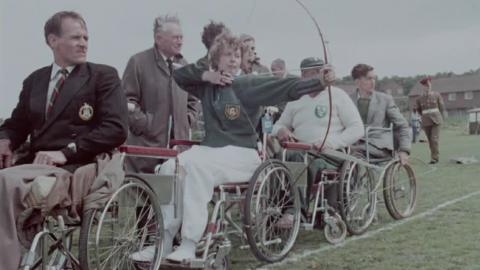This film is part of Free

Chairbound
Do wheelchairs liberate or constrain? The early years of Stoke Mandeville hospital and the Paralympics.
Overview
Are wheelchairs symbols of liberation or do they constrain disabled people’s lives? This 1964 film introduces us to the National Spinal Injuries Centre at Stoke Mandeville, which helps newly-disabled people to recover from spinal trauma and live independently. Although not allowed to speak for themselves, the people in the film show a remarkable tenacity to lead an ordinary (the film describes it as “normal”) life. It includes scenes from the International Stoke Mandeville Games, which eventually became the Paralympics.
Wheelchair users often describe their ‘chair as a tool for enabling independent living - an object of liberation, rather than an object that binds you. The film reinforces this view. However, with its eagerly optimistic tone, it also skates over the often complicated and sometimes painful physical and psychological transition from non-disabled to disabled person. The film includes footage of a unique housing development that was designed to be fully accessible for wheelchairs. These days, accessible housing is being integrated into mainstream design and housing developments, rather than being segregated into a separate estate. In 2012, the BBC broadcast the film The Best of Men about Ludwig Guttman, the German refugee neurologist who transformed Stoke Mandeville and created the Paralympic games.
Related

Eyes of a Child Eyes of a Child
Government sponsored film 1961 31 mins Location: Dorton Ho (Sch)
Young imaginations run wild at School for Blind Children.

An Ordinary Life An Ordinary Life
1985 29 mins
“I’d much rather work at a computer than make wicker baskets” – disabled people hit the mainstream in 1980s Britain

It's a New World It's a New World
Instructional film/TV programme 1977 30 mins
Early attempts at inclusive swimming for disabled people.

Three for Society Three for Society
1969 29 mins
Feisty and free-spirited, three disabled people talk frankly and directly about the barriers they experience in the 1960s

Like Other People Like Other People
Documentary 1972 51 mins
Man Alive! moral panic, sex, and when professionals ruled – life as a disabled couple in 1972

Artificial Limb Making Artificial Limb Making
Non-Fiction 1916 1 mins Silent
Occupational therapy turns full circle, as amputee soldiers learn to make artificial limbs for others

All We Imagine As Light - Exclusive Q&A All We Imagine As Light - Exclusive Q&A
Short interview 2025 28 mins
Payal Kapadia discusses her Cannes prize-winning and Bafta-nominated drama with Ashanti Omkar.

Khichdi Khichdi
Animation & Artists Moving Image 2023 16 mins
The interwoven stories of four best friends who reunite in the UK, thirty-five years after training together as nurses during their teens in Ferozepur, Punjab.

Dr XYZ: A Medical Drag Transthology Dr XYZ: A Medical Drag Transthology
Documentary 2023 15 mins
A satirical take on the healthcare service announcements of the 1960s and 70s.

Every Moment Counts Every Moment Counts
Animation & Artists Moving Image 2023 9 mins
A short animation that offers a window into the world of children’s palliative care.

Police Story: Panel Discussion Police Story: Panel Discussion
Inside Film 2024 24 mins
Panel discussion on Jackie Chan's 1985 action classic Police Story, with Chase Armitage, Sam Mak and Jadey Duffield.

China O'Brien: The Reunion China O'Brien: The Reunion
Documentary 2024 60 mins
Cynthia Rothrock, Richard Norton and Keith Cooke reunite three decades on from the groundbreaking martial arts classic.